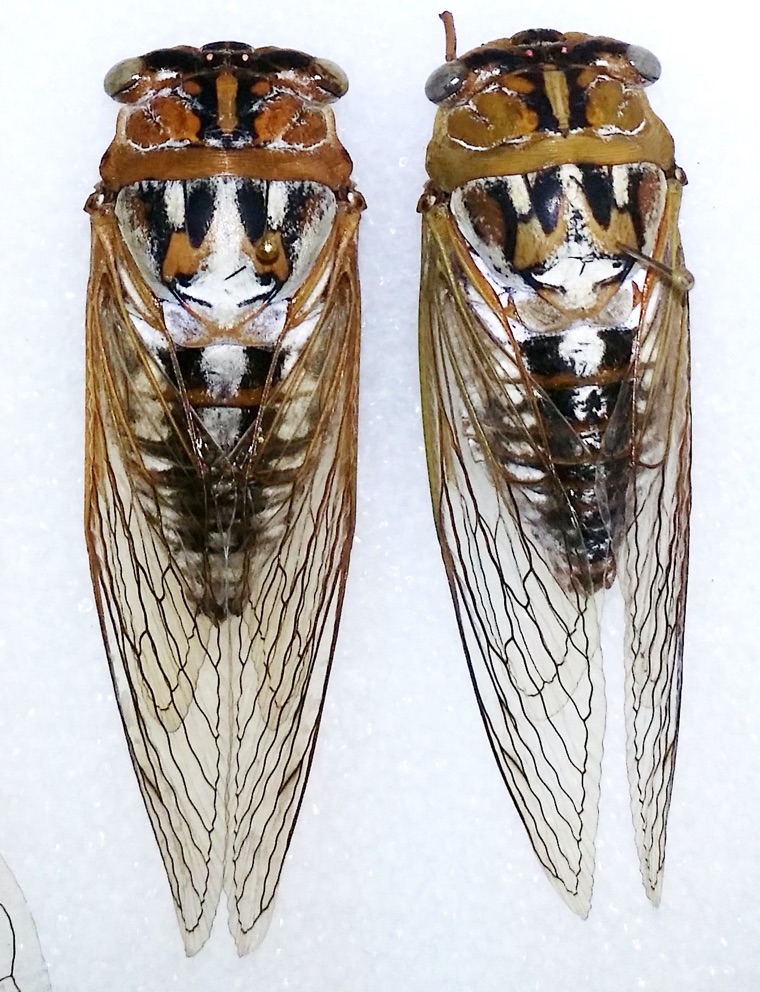Megatibicen dealbatus (Davis, 1915) aka Plains Cicada.

Megatibicen dealbatus from Bill Reynolds collection. All M. dealbatus images and information on this website.
Song
Source: ©Insect Singers
Video Playlist
Playlists contain multiple videos found on YouTube.
Name, Location and Description
- Cicada Name: Megatibicen dealbatus (Davis, 1915)
- Short Name: M. dealbatus
- Common Name: Plains Cicada
- Synonym/Former Name: Tibicen dealbatus, Cicada dealbata, Cicada marginata var. dealbata
- When: July-September. Peaks in August.
- Where it is found: CO, IA, KS, MT, NE, NM, ND, OK, SD, TX, WY
- Maps: Biogeography of the Cicadas (Hemiptera: Cicadidae) of North America, North of Mexico [PDF]
- Description: Primarily either orange/rust or pea green, brown, black with heavy pruninosity which forms distinct markings on dorsal side of body. Dorsal side has two black stripes framed by three areas of pruinosity. Sounds like N. pronotalis.
- Eye Color: beige
- Pronotal Collar Color: light orange or olive
- Identification: Bug Guide
- Identification: iNaturalist
- Type Specimen Details: The American Museum of Natural Species
- Image: Insect Images
- Taxonomic Information: Integrated Taxonomic Information System
- Song: Insect Singers
A description by Wm. T. Davis.
The description comes from Wm. T. Davis’ document A NEW VARIETY OF CICADA RESEMBLING C. DORSATA. from September, 2015, published in the Journal of the New York Entomological Society. Vol. 23: 161-164.
Markings resembling those of C. dorsata [now M. dorsatus], but marginata var. dealbata is more green in color and has less black about the central area of the pronotum. The mesonotum is marked as in dorsata but is more pruinose ; the turgum has a dorsal line of white spots as in dorsata, but the sides are broadly pruinose and the posterior margin of each segment is narrowly edged with greenish yellow. Beneath both insects may be of the same color, though dorsata is usually much darker. The opercula are about as broad as long and broadly rounded at the tips. The fore wings in dorsata are oval in shape with the inner side (radius) of the costal margin blackish ; the veins are heavy and thickened, and the W-mark is prominent, whereas in luarginata var. dealbata the fore wings are more acuminate in form, the costal margin is green, darkened beyond the middle of the wing and the W-mark is not conspicuous or is wanting. One of the greatest differences between the two insects is in the genitalia. The uncus in dorsata viewed at full face is narrow and the piece below into which it locks is broadly notched with the extremities rounded. In var. dealbata the uncus is more nearly triangular in shape and the lower piece is narrowly notched with the extremities much produced. The male type of var. dealbata is figured.
Length of body 35 mm. ; length of fore wing 46 mm. ; expanse of wings 105 mm.
Classification:
Family: Cicadidae
Subfamily: Cicadinae
Tribe: Cryptotympanini
Subtribe: Cryptotympanina
Genus: Megatibicen
Species: Megatibicen dealbatus (Davis, 1915)
List of sources
- Davis, W.T. A NEW VARIETY OF CICADA RESEMBLING C. DORSATA. 1915. The Journal of the New York Entomological Society. 23:161-164. Link to the paper.
- Full Binomial Names: ITIS.gov
- Common names: BugGuide.net; The Songs of Insects by Lang Elliott and Wil Herschberger; personal memory.
- Locations: Biogeography of the Cicadas (Hemiptera: Cicadidae) of North America, North of Mexico by Allen F. Sanborn and Polly K. Phillips.
- Descriptions, Colors: personal observations from specimens or photos from many sources. Descriptions are not perfect, but may be helpful.
10 replies on “Megatibicen dealbatus (Davis, 1915) aka Plains Cicada”
Just heard Cicadas for the first time this summer here in Roswell, NM. I know this is the first time as I always listen for them. I don’t know why, but their singing is beautiful to me. Somehow…comforting? I know, I’m weird.
You’re wonderful.
We are in Omaha Nebraska.
Perfect location for them.
My granddaughters and I just found one singing in a woods near by. So neat
My dog just found one here in Mineral Point, Wisconsin. Southwest part of state. I didn’t know what it was until I looked it up. I have never seen one before that looked like this. Black and silver. So very interesting!!!!!
So far I have encountered two here in Alpine, Wyoming. I have never seen one here before in the 17 years I have been here. I came from Maryland and have seen the 17 year ones many times in my 76 years. These are amazing creatures. I’m so happy they have shown up. I took a picture, but am unable to send it to you.
Hi Peggy, I received the link to your photo. Your cicada is definitely a member of the genus Okanagaga, which are common in Wyoming. The closest match I found was Okanagana fratercula.
I’ve lived in western Kansas most of my life. I’ve always known summer is coming to an end when I start hearing these “locusts” as everyone calls them here.
Now I know they are an annual cicada! Dealbatus or Plains cicada!
Thanks for the beautiful informative entries. These calls take me back two thirds of a century to my childhood in Bismarck, ND. Megatibicen– at least by this recording– is quite loud compared to many recordings of Brood X, for example, at the Cicada Mania website, and that loudness I do remember from my hammock on a summer’s day!